Case Based Questions Test: Work, Energy & Power - NEET MCQ
10 Questions MCQ Test Topic-wise MCQ Tests for NEET - Case Based Questions Test: Work, Energy & Power
Ballistic pendulum
The ballistic pendulum was invented in 1742 by English mathematician Benjamin Robins. A Ballistic Pendulum is a device for measuring a bullet’s momentum and speed by employing perfectly inelastic collision. A large wooden block suspended by two cords serves as the pendulum bob. When a bullet is fired into the bob, it gets embedded in the bob and its momentum is transferred to the bob. The bullet’s momentum and velocity can be determined from the amplitude of the pendulum swing. The velocity of the bullet, in turn, can be derived from its calculated momentum.
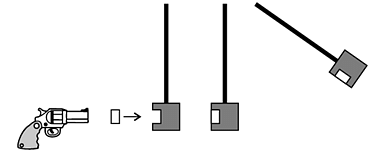
After collision, if the pendulum reaches a height h, then from principle of conservation of mechanical energy

where,
m = mass of bullet
M = mass of the bob
vP = velocity of the bob-bullet combination
∴ 
Now, Momentum before collision = Momentum after collision

where,
vB = velocity of bullet
∴ 
The ballistic pendulum used to be a common tool for the determination of the muzzle velocity of bullets as a measure of the performance of firearms and ammunition (Nowadays, the ballistic pendulum. has now been replaced by the ballistic chronograph, an electronic device).
In ballistic pendulum the collision is

Ballistic pendulum
The ballistic pendulum was invented in 1742 by English mathematician Benjamin Robins. A Ballistic Pendulum is a device for measuring a bullet’s momentum and speed by employing perfectly inelastic collision. A large wooden block suspended by two cords serves as the pendulum bob. When a bullet is fired into the bob, it gets embedded in the bob and its momentum is transferred to the bob. The bullet’s momentum and velocity can be determined from the amplitude of the pendulum swing. The velocity of the bullet, in turn, can be derived from its calculated momentum.
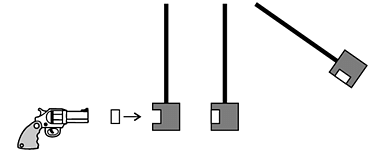
After collision, if the pendulum reaches a height h, then from principle of conservation of mechanical energy

where,
m = mass of bullet
M = mass of the bob
vP = velocity of the bob-bullet combination
∴ 
Now, Momentum before collision = Momentum after collision

where,
vB = velocity of bullet
∴ 
The ballistic pendulum used to be a common tool for the determination of the muzzle velocity of bullets as a measure of the performance of firearms and ammunition (Nowadays, the ballistic pendulum. has now been replaced by the ballistic chronograph, an electronic device).
The ballistic pendulum was invented by a

| 1 Crore+ students have signed up on EduRev. Have you? Download the App |
Ballistic pendulum
The ballistic pendulum was invented in 1742 by English mathematician Benjamin Robins. A Ballistic Pendulum is a device for measuring a bullet’s momentum and speed by employing perfectly inelastic collision. A large wooden block suspended by two cords serves as the pendulum bob. When a bullet is fired into the bob, it gets embedded in the bob and its momentum is transferred to the bob. The bullet’s momentum and velocity can be determined from the amplitude of the pendulum swing. The velocity of the bullet, in turn, can be derived from its calculated momentum.

After collision, if the pendulum reaches a height h, then from principle of conservation of mechanical energy

where,
m = mass of bullet
M = mass of the bob
vP = velocity of the bob-bullet combination
∴ 
Now, Momentum before collision = Momentum after collision

where,
vB = velocity of bullet
∴ 
The ballistic pendulum used to be a common tool for the determination of the muzzle velocity of bullets as a measure of the performance of firearms and ammunition (Nowadays, the ballistic pendulum. has now been replaced by the ballistic chronograph, an electronic device).
A ballistic pendulum of 1 kg is fired with a bullet of mass 1 g. If the pendulum rises 2 cm, find the velocity of the bullet.

Ballistic pendulum
The ballistic pendulum was invented in 1742 by English mathematician Benjamin Robins. A Ballistic Pendulum is a device for measuring a bullet’s momentum and speed by employing perfectly inelastic collision. A large wooden block suspended by two cords serves as the pendulum bob. When a bullet is fired into the bob, it gets embedded in the bob and its momentum is transferred to the bob. The bullet’s momentum and velocity can be determined from the amplitude of the pendulum swing. The velocity of the bullet, in turn, can be derived from its calculated momentum.
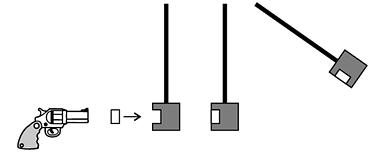
After collision, if the pendulum reaches a height h, then from principle of conservation of mechanical energy
![]()
where,
m = mass of bullet
M = mass of the bob
vP = velocity of the bob-bullet combination
∴ ![]()
Now, Momentum before collision = Momentum after collision
![]()
where,
vB = velocity of bullet
∴ ![]()
The ballistic pendulum used to be a common tool for the determination of the muzzle velocity of bullets as a measure of the performance of firearms and ammunition (Nowadays, the ballistic pendulum. has now been replaced by the ballistic chronograph, an electronic device).
Which two principles of Physics are applied to find the velocity of the bullet?
Ballistic pendulum
The ballistic pendulum was invented in 1742 by English mathematician Benjamin Robins. A Ballistic Pendulum is a device for measuring a bullet’s momentum and speed by employing perfectly inelastic collision. A large wooden block suspended by two cords serves as the pendulum bob. When a bullet is fired into the bob, it gets embedded in the bob and its momentum is transferred to the bob. The bullet’s momentum and velocity can be determined from the amplitude of the pendulum swing. The velocity of the bullet, in turn, can be derived from its calculated momentum.

After collision, if the pendulum reaches a height h, then from principle of conservation of mechanical energy
![]()
where,
m = mass of bullet
M = mass of the bob
vP = velocity of the bob-bullet combination
∴ ![]()
Now, Momentum before collision = Momentum after collision
![]()
where,
vB = velocity of bullet
∴ ![]()
The ballistic pendulum used to be a common tool for the determination of the muzzle velocity of bullets as a measure of the performance of firearms and ammunition (Nowadays, the ballistic pendulum. has now been replaced by the ballistic chronograph, an electronic device).
Ballistic pendulum has been replaced by
Clockwork refers to the inner workings of mechanical clock or watch (where it is known as “movement”) and different types of toys which work using a series of gears driven by a spring. Clockwork device is completely mechanical and its essential parts are:
• A key (or crown) which you wind to add energy
• A spiral spring in which the energy is stored
• A set of gears through which the spring's energy is released. The gears control how quickly (or slowly) a clockwork machine can do things. Such as in mechanical clock / watch the mechanism is the set of hands that sweep around the dial to tell the time. In a clockwork car toy, the gears drive the wheels.
Winding the clockwork with the key means tightening a sturdy metal spring, called the mainspring. It is the process of storing potential energy. Clockwork springs are usually twists of thick steel, so tightening them (forcing the spring to occupy a much smaller space) is actually quite hard work. With each turn of the key, fingers do work and potential energy is stored in the spring. The amount of energy stored depends on the size and tension of the spring. Harder a spring is to turn and longer it is wound, the more energy it stores.

While the spring uncoils, the potential energy is converted into kinetic energy through gears, cams, cranks and shafts which allow wheels to move faster or slower. In an ancient clock, gears transform the speed of a rotating shaft so that it drives the second hand at one speed, the minute hand at 1/60 that speed, and the hour hand at 1/3600 that speed. Clockwork toy cars often use gears to make themselves race along at surprising speed.
What is the meaning of “movement” of old age mechanical clocks?
Clockwork refers to the inner workings of mechanical clock or watch (where it is known as “movement”) and different types of toys which work using a series of gears driven by a spring. Clockwork device is completely mechanical and its essential parts are:
• A key (or crown) which you wind to add energy
• A spiral spring in which the energy is stored
• A set of gears through which the spring's energy is released. The gears control how quickly (or slowly) a clockwork machine can do things. Such as in mechanical clock / watch the mechanism is the set of hands that sweep around the dial to tell the time. In a clockwork car toy, the gears drive the wheels.
Winding the clockwork with the key means tightening a sturdy metal spring, called the mainspring. It is the process of storing potential energy. Clockwork springs are usually twists of thick steel, so tightening them (forcing the spring to occupy a much smaller space) is actually quite hard work. With each turn of the key, fingers do work and potential energy is stored in the spring. The amount of energy stored depends on the size and tension of the spring. Harder a spring is to turn and longer it is wound, the more energy it stores.
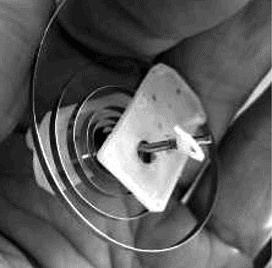
While the spring uncoils, the potential energy is converted into kinetic energy through gears, cams, cranks and shafts which allow wheels to move faster or slower. In an ancient clock, gears transform the speed of a rotating shaft so that it drives the second hand at one speed, the minute hand at 1/60 that speed, and the hour hand at 1/3600 that speed. Clockwork toy cars often use gears to make themselves race along at surprising speed.
When the spring of a clockwork uncoils
Clockwork refers to the inner workings of mechanical clock or watch (where it is known as “movement”) and different types of toys which work using a series of gears driven by a spring. Clockwork device is completely mechanical and its essential parts are:
• A key (or crown) which you wind to add energy
• A spiral spring in which the energy is stored
• A set of gears through which the spring's energy is released. The gears control how quickly (or slowly) a clockwork machine can do things. Such as in mechanical clock / watch the mechanism is the set of hands that sweep around the dial to tell the time. In a clockwork car toy, the gears drive the wheels.
Winding the clockwork with the key means tightening a sturdy metal spring, called the mainspring. It is the process of storing potential energy. Clockwork springs are usually twists of thick steel, so tightening them (forcing the spring to occupy a much smaller space) is actually quite hard work. With each turn of the key, fingers do work and potential energy is stored in the spring. The amount of energy stored depends on the size and tension of the spring. Harder a spring is to turn and longer it is wound, the more energy it stores.
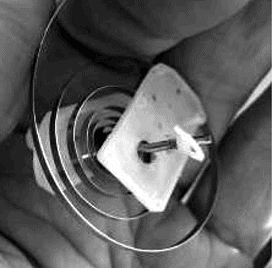
While the spring uncoils, the potential energy is converted into kinetic energy through gears, cams, cranks and shafts which allow wheels to move faster or slower. In an ancient clock, gears transform the speed of a rotating shaft so that it drives the second hand at one speed, the minute hand at 1/60 that speed, and the hour hand at 1/3600 that speed. Clockwork toy cars often use gears to make themselves race along at surprising speed.
More energy is stored in a spring if the
Clockwork refers to the inner workings of mechanical clock or watch (where it is known as “movement”) and different types of toys which work using a series of gears driven by a spring. Clockwork device is completely mechanical and its essential parts are:
• A key (or crown) which you wind to add energy
• A spiral spring in which the energy is stored
• A set of gears through which the spring's energy is released. The gears control how quickly (or slowly) a clockwork machine can do things. Such as in mechanical clock / watch the mechanism is the set of hands that sweep around the dial to tell the time. In a clockwork car toy, the gears drive the wheels.
Winding the clockwork with the key means tightening a sturdy metal spring, called the mainspring. It is the process of storing potential energy. Clockwork springs are usually twists of thick steel, so tightening them (forcing the spring to occupy a much smaller space) is actually quite hard work. With each turn of the key, fingers do work and potential energy is stored in the spring. The amount of energy stored depends on the size and tension of the spring. Harder a spring is to turn and longer it is wound, the more energy it stores.
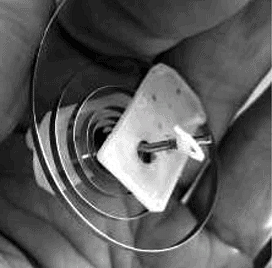
While the spring uncoils, the potential energy is converted into kinetic energy through gears, cams, cranks and shafts which allow wheels to move faster or slower. In an ancient clock, gears transform the speed of a rotating shaft so that it drives the second hand at one speed, the minute hand at 1/60 that speed, and the hour hand at 1/3600 that speed. Clockwork toy cars often use gears to make themselves race along at surprising speed.
What type of energy is stored in the spring while winding it?
Clockwork refers to the inner workings of mechanical clock or watch (where it is known as “movement”) and different types of toys which work using a series of gears driven by a spring. Clockwork device is completely mechanical and its essential parts are:
• A key (or crown) which you wind to add energy
• A spiral spring in which the energy is stored
• A set of gears through which the spring's energy is released. The gears control how quickly (or slowly) a clockwork machine can do things. Such as in mechanical clock / watch the mechanism is the set of hands that sweep around the dial to tell the time. In a clockwork car toy, the gears drive the wheels.
Winding the clockwork with the key means tightening a sturdy metal spring, called the mainspring. It is the process of storing potential energy. Clockwork springs are usually twists of thick steel, so tightening them (forcing the spring to occupy a much smaller space) is actually quite hard work. With each turn of the key, fingers do work and potential energy is stored in the spring. The amount of energy stored depends on the size and tension of the spring. Harder a spring is to turn and longer it is wound, the more energy it stores.

While the spring uncoils, the potential energy is converted into kinetic energy through gears, cams, cranks and shafts which allow wheels to move faster or slower. In an ancient clock, gears transform the speed of a rotating shaft so that it drives the second hand at one speed, the minute hand at 1/60 that speed, and the hour hand at 1/3600 that speed. Clockwork toy cars often use gears to make themselves race along at surprising speed.
In clockwork devices, ............... transform the speed of a rotating ............... to drive wheels slower or faster..
|
9 docs|1272 tests
|


















